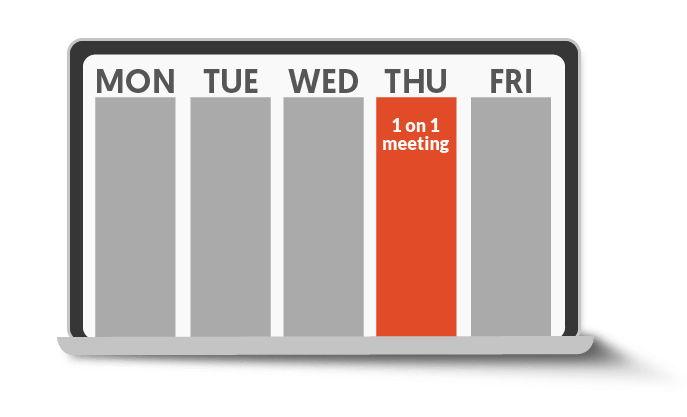
How to Run a Successful Employee Meeting That Packs Value for Both You and Your Direct Reports
Editor’s Note: This post is brought to you by a new contributor, Hiba Amin, from our friends over at Hypercontext – a solution that empowers over 100,000 managers to lead high-performing teams.
A study by Hypercontext found that 72% of managers think employee meetings are the most, or one of the most important things they do to manage the performance of their teams. While employee meetings (like your one-on-ones) are incredibly valuable to managers, when not done right they diminish the value your agents bring back to their seats.
That’s why it’s so important to focus on how to make every employee meeting successful for both parties. When you do, business outcomes and employee happiness thrive.
In this article, we’ll walk through 6 ways to run better, more effective manager-agent meetings with your team:
- Set a goal for the meeting collaboratively
- Let your direct report own and lead the meeting
- Be empathetic and practice vulnerable leadership
- Use a meeting agenda
- Never ever cancel or reschedule
- Bring recognition into every employee meeting
Let’s get started!
1. Set a goal for the meeting collaboratively
Every agent is different. From how they like to communicate to what motivates them at work. That’s why it’s so important that you approach every employee meeting in a way that’s personalized to each agent. The best way to make this time valuable for both of you? Talk about it.
During your next agent check-in, kick the meeting off by setting a goal for this time collaboratively. Here’s an example of what you can say:
“Hey [name],
I really value our one-on-one time together and want to make sure that you’re getting value out of this time too. So, I’d love it if we can spend some time and discuss what we’re both hoping to get out of this meeting. For me, I want to learn about any challenges or roadblocks you run into, talk about your professional goals, and continue to understand what excites you at work (and what doesn’t).
What are some things that you’re hoping to get out of these meetings?”
Once you’re able to nail down your meeting goal, add it to your meeting description or calendar invite so that it’s always top of mind for both you and your agent.
Hold each other accountable
It’s one thing to set a goal, it’s another to stick to it. If you find that your meetings no longer serve the goal you’ve set with your agent, it’s critical to hold each other accountable for having the right conversations. This is the difference between an effective meeting that engages your agent and one that’s a waste of time.
On top of that, it’s natural for goals and expectations to change. That’s why it’s important to also revisit your meeting goal every so often (every 3-6 months) to ensure you’re consistently driving value during this meeting.
2. Let your direct report own and lead the meeting
Over 200 managers were asked the question “Who owns the one-on-one meeting agenda?” Some 49% said they share the responsibility with their direct report.
While both managers and agents (or your supervisors and agents) both contribute to the conversation in one-on-ones, treat this meeting as an employee’s time and space to share what’s on their mind. Employee meetings are one of the best tools for managers to truly engage their agents, but only if you’re able to take a step back and let your agent drive the conversation.
Set expectations
As you’re discussing what you’d both like to get out of the meeting, it’s also important to set expectations. This includes things like:
- Showing up prepared for every meeting
- Adding all items to the shared agenda at least 24 hours before the meeting
- Letting your agent know that this is their time with you, and as a result, they’ll lead the meeting.
One of the best ways to show employees that they’re really in the driver’s seat is to prioritize all of their agenda items first. This will ensure that you’re able to discuss all of the things that matter most to them.
3. Be empathetic and practice vulnerable leadership
Trust is the foundation of any manager-employee relationship. The best way to build trust? By being empathetic and practicing vulnerable leadership.
Vulnerable leadership
It’s important to recognize that, as a manager, you’re in the position of power. That means you’re ultimately the one who sets the tone for how open you and your employees can be with one another. If you want your direct reports to open up to you, you’re going to have to open up first.
During employee meetings, some ways you can open up include saying things like:
- “I’m a very forgetful person by nature. That’s why I like to write things down so that I’m holding myself accountable for the things I commit to. If you’re ever waiting on something from me, I encourage you to remind me because I don’t want to be a blocker for you ever.”
- “I’ve been having a really hard time right now in my personal life and it’s affecting my motivation and productivity. I’ve also noticed that I’m much more productive and energetic at night, so for the next week, I’ll be starting and ending work later until things settle and I can be 100% with the team! I hope you understand.”
- “At the start of my career, I was really nervous on every customer call. After every call, I wrote down all of the things I wanted to focus on improving and the things I was really great at. Over time, this really helped boost my confidence and I was a lot more comfortable on the phone.”
Vulnerability doesn’t have to mean waterworks. In fact, just showing an agent that you’re human will help them open up when they’re struggling or thriving!
Leading with empathy
2020 has felt like a year with no end in sight (and we still have two seasons left to weather); it’s been an incredibly emotionally taxing and draining year. As a manager, it’s important that you understand the importance of how to lead with empathy during times of heightened stress. How you lead your team today will have a major impact on whether or not your team will trust you in the future. Why? Because it’s easy to lead when things are great and everyone is feeding off of the energy that comes with success. This is harder to do in times of turmoil.
So, if you’re hoping to be a better manager during times of crisis, here are some things you can do:
- Make yourself available to your team and let them know that you’re there for them, even if they just want to talk.
- Make it your mission to understand how every agent on the team likes to communicate, receive feedback, and get a pulse on how they’re feeling overall.
- Foster a culture of psychological safety on the team.
- Give your team permission to be unproductive. Adding more pressure and anxiety to an already stressful situation will do more harm than good.
- Give yourself permission to be unproductive. If you want to be completely present for your team, focus on what you need to be able to do that.
4. Use a meeting agenda
An Atlassian report found that the average employee spends 31 hours in unproductive meetings each month. Nothing is worse than leaving a meeting feeling like it was a waste of time. So, how do you ensure that you’re having effective employee meetings? You guessed it!
By using a meeting agenda. Having a collaborative agenda ensures that:
- You and your agent show up to meetings prepared, always.
- You’re able to best prioritize what to discuss first and what can wait.
- Quieter agents have another medium to share their thoughts, questions, and concerns.
- You’ll always have a place to refer back to when looking through your meeting notes.
If you’re not sure what to discuss during these meetings, there are one-on-one meeting templates that can help inspire great conversations between you and your agents.
Assign action items
When the conversation is over, be sure to document all action items that you agreed on. Assigning action items will ensure you’re able to hold one another accountable for getting things done. For action items to be truly effective, be sure to:
- Assign them to a specific individual.
- Set a due date.
- Document them in the meeting agenda.
- Send them out in the meeting notes once the meeting is over.
5. Never ever cancel or reschedule
Treat each employee meeting as your most sacred meeting of the week. Not only is consistency great for building a productive rhythm to your workweek, but it sends the right message to your team: they’re your priority.

Now, I know that supervising a team can get very overwhelming from time-to-time. However, it’s important that, regardless of how busy you are, you always prioritize your team and these meetings over everything else. In fact, not doing so can actually cause more stress and make you (and your team) less productive.
A Harvard Business Review study found that when you cancel or reschedule employee meetings, you’re ultimately:
- Increasing your risk of a flooded inbox.
- Showing employees that they’re not a priority.
- Removing an important feedback sharing opportunity, and thus delaying you and your team’s ability to improve and grow.
The lesson here? Never cancel or reschedule. Unless of course, you’re out of office. Then, reschedule to set an example for your team – that it’s okay to take vacation. AND to disconnect while you do.
6. Bring recognition into every employee meeting
There is a direct correlation between recognition and employee engagement. A recent Bonusly report found that 84% of highly engaged employees were recognized the last time they went above and beyond, compared to only 25% of highly disengaged employees. Plus, sharing recognition will certainly put a smile on your team’s face and who doesn’t want that?
Recognition is an incredible motivation tool for any call center manager. It’s also an effective way of encouraging the right behavior and habits you’re hoping to embed into the team. Did someone have a great customer call? Highlight that behavior and why; others will follow suit.
When it comes to every employee meeting, impactful recognition is:
- Timely: Share feedback when the actions are fresh in the agent’s mind.
- Frequent: Don’t reserve praise for the quarterly or annual performance review.
- Specific: How did your agent go above and beyond, how did it make you feel, and why did it impress you?
- Inclusive: Show employees that not only do they belong, but their opinions do too. Encourage upwards recognition across your company, not just top-down.
- Values-based: How does the recognition you give link back up to organizational values?
- Visible: Communicate your recognition outside of your employee meetings too! Whether it’s in your Slack group, during your team meeting, or even a company all-hands!
The key to building great relationships with your agents is running an effective employee meeting with each person to build trust. Doing this will ultimately make your team more productive, allowing you to hit team goals faster.


